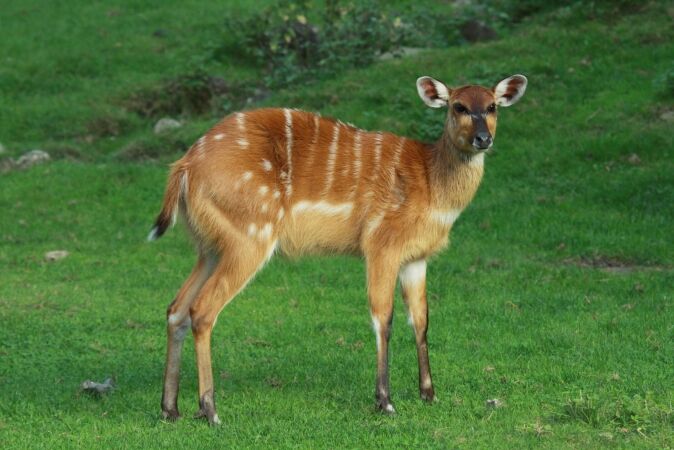

The sitatunga (Tragelaphus spekii) is a medium-sized amphibious antelope native to central Africa. Often referred to as a marshbuck, this antelope enjoys a habitat of swamps and marshlands.
There are three recognized subspecies of the Sitatunga antelope:
The Western sitatunga is found in central and western Africa, and its habitats include lakes, wetlands, swamps, and marshlands. It is listed by the International Union for the Conversation of Nature (IUCN) with a status of “least concern.”
The sitatunga is herbivorous, enjoying a diet of reeds, aquatic grasses, flowers, buds, and seeds. Predators of the antelope include leopards, lions, and wild dogs. When chased, the sitatunga will head for the water, and with their specially adapted splayed hooves that allow them to easily walk through soft and muddy terrain, they are quickly able to reach it. Once there, these exceptional swimmers head to deeper water, keeping only their nostrils visible to evade predators.
Breeding occurs throughout the year, with females giving birth to one offspring. The sitatunga is nocturnal and diurnal, although they are more active at dusk and dawn, preferring to rest in the shade of the reeds during the day.
Name:
Tragelaphus spekii gratus
Male Weight:
150-280 pounds
Male Shoulder Height:
35-49 inches
Horns:
Males only
Range:
West and Central Africa
Gestation Period:
247 days
Life span:
> 11 years
Hunting the Sitatunga Leads you Through Swamps, Marshes, and Mud
The male sitatunga is the larger of the sexes, with males tipping the scales at 150-280 pounds and standing approximately 35-49 inches at the shoulder. Female sitatunga are smaller and weigh 110-125 pounds, standing 30-35 inches at the shoulder. Only the male sitatunga has spiral-shaped horns that grow between 18-36 inches. The sitatunga is a medium-sized antelope with the subspecies of the Zambezi sitatunga sporting brilliant coats. The ram has a dark brown coat with many white markings across it, while the ewe’s coat is a prominent reddish-brown. Their coats are shaggy with longish hair, and they have an oily, waterproof type secretion that keeps them dry in wet terrain and conditions. Both males and females have two white marks between their eyes as well as white spots on their cheeks. Their tails are dark above, with light coloring below. Their hind legs are longer than the front ones, with feet and hooves specifically adapted to walk in wet conditions and swim in water. These hooves are widely splayed, allowing them to quickly and easily move in the wet terrain.
Sitatunga antelopes are a challenge to hunt. But with that challenge comes the excitement and thrill of targeting this semi-aquatic antelope! Hunting safari methods include ambushing the antelope from a blind or targeting it as you slowly make your way through marshlands and river habitats in a traditional canoe or mokoro. Whichever hunting technique you decide on, remember that precise shot placement remains paramount.
The reward of this hunting adventure most definitely includes the background of how you targeted the antelope, the conditions, as well as the terrain, and the absolute excitement of this hunting safari! Think wet, think water, think the slow progress of the canoe as it silently makes its way downstream! Patience is the name of the game on this African hunt, whether it involves sitting in the blind waiting to ambush the antelope or slowly and carefully making your way through marshlands and swamps, sitatunga hunting ticks all the boxes of an enthralling hunting adventure!
Sitatunga hunting in Africa is an enthralling experience that calls for a fast-shooting rifle. With the shooting ranges for this antelope including distances of 100-400 yards, a good quality tactical scope is also advised for a successful African hunt. The hunter can consider calibers from a .270 to a 300 win-mag. with a 7mm as another decent option for a sitatunga hunting adventure.
Search from our range of Hunts across various popular destinations in Africa.
Find A Hunt